Eastern Screech-Owl
Description
The Eastern Screech-Owl (Megascops asio) is a small, adaptable owl species found in Georgia. Measuring between 16 to 25 cm in size and weighing 121 to 244 g, these owls exhibit two distinct color morphs – a rich reddish hue in southern populations and a dusky greyish plumage in northern populations. They possess a complex pattern of bands and spots on their feathers, resembling tree bark, and feature ear tufts and bright yellow eyes, giving them a distinctive appearance.

Habitat and Range
Eastern screech owls are versatile and can be found in a variety of habitats including mature deciduous forests, parks, and suburban areas with large trees. They are well-adapted to human development and can often be spotted in residential areas near parks and wooded areas. In Georgia, they are widespread, extending from rural to suburban areas, as long as there are suitable roosting sites and prey available.
16 Types of Owls in Texas
Behavior
These owls are typically solitary except during the mating season in April when they form pairs. They engage in bonding behaviors during courtship, often forming lifelong bonds. While generally monogamous, some males have been observed mating with multiple females. Eastern screech owls are nocturnal hunters, relying on their keen hearing to locate prey. They primarily feed on small mammals like voles, mice, and shrews, as well as insects, reptiles, birds, amphibians, and occasionally fruits and berries.
Unique Characteristics and Identification
Eastern screech owls are known for their excellent camouflage, blending seamlessly into their surroundings with their grey and red-brown patterned feathers. Their short and stout bodies, small rounded wings, and square tails contribute to their distinctive appearance. They have ear tufts resembling horns and bright yellow eyes. Their trills, similar to a horse’s whinny, can often be heard at night near their nesting sites.
Where to Find Them
In Georgia, Eastern Screech-Owls can be found in areas with large mature trees, particularly those with hollow trunks which they use as nesting sites. Some recommended locations for spotting them include Panola Mountain State Park, Sweetwater Creek State Park, Don Carter State Park, and Fort Mountain State Park.
Diet
Eastern screech owls have a varied diet, consisting of earthworms, lizards, frogs, tadpoles, crayfish, and various small mammals. They are opportunistic feeders and adapt their diet based on what is available in their environment. They hunt primarily at night, using their exceptional hearing to locate prey and swallow their prey whole, regurgitating indigestible parts in the form of pellets.
Burrowing Owl
Description
The Burrowing Owl (Athene cunicularia) is a distinctive small owl species native to the Americas, including parts of Georgia. Measuring between 7.5 to 9.8 inches in length with a wingspan of approximately 21 inches, these owls are characterized by their round heads, long legs, and compact bodies. Their plumage displays a blend of mottled brown, white, and sandy tan, featuring barred patterns on the belly and breast. Notably, both male and female Burrowing Owls exhibit similar sizes, unlike many other owl species.
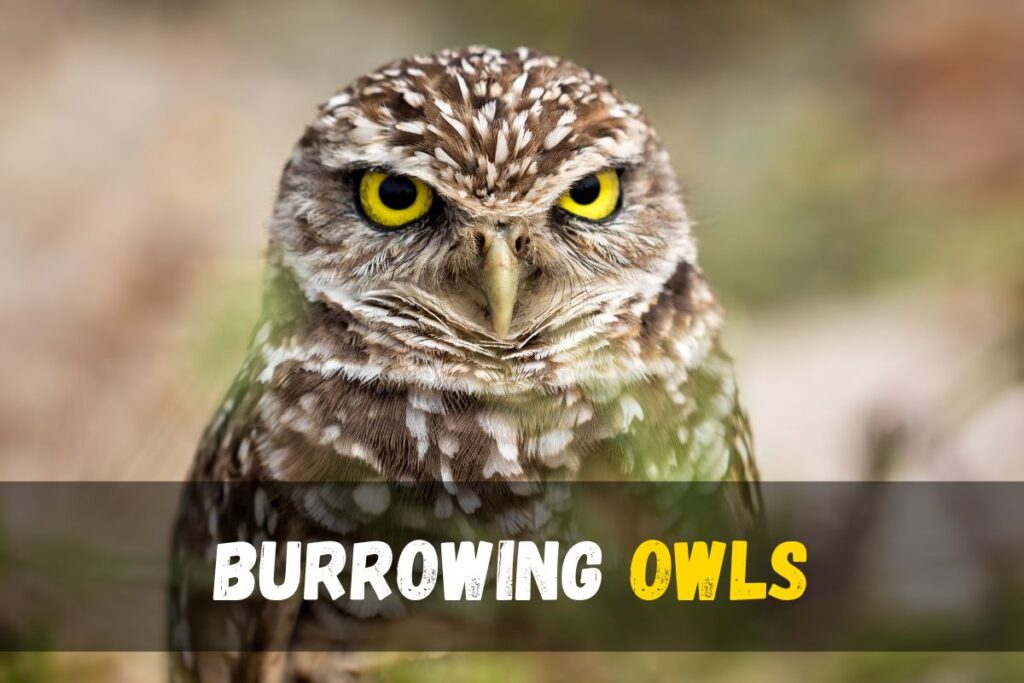
Habitat and Range
Burrowing Owls are primarily found in open grasslands, prairies, and sparsely vegetated areas, making them well-suited to habitats across Georgia. They are often associated with areas where short vegetation allows for easy detection of both predators and prey. While they are not commonly seen in Georgia compared to western regions, they can still be found in certain parts of the state, particularly in the southern and western regions.
Behavior
One of the distinctive behaviors of the Burrowing Owl is its diurnal nature, being active during the day, unlike most owl species. They are known for their unique “bouncing” gait as they move across the ground. Burrowing Owls exhibit a preference for hunting close to vegetation, sheltering them in case of potential threats. They are also skilled at storing surplus food in underground storage dens, ensuring a stable food supply during winter months.
Unique Characteristics and Identification
Identifying features of the Burrowing Owl include its sandy-tan and white plumage, along with its striking bright yellow eyes and white eyebrows. These owls feature a small to medium-length bill, and their unique appearance makes them fairly conspicuous despite their modest size. Additionally, they are the only owl species known to roost underground, utilizing burrows dug by other animals such as prairie dogs or, in the case of Florida subspecies, digging their own burrows.
Where to Find Them
In Georgia, Burrowing Owls can be found in various habitats including grasslands, agricultural fields, and even airports. They are most commonly encountered in the southern and western parts of the state. While not as prevalent as in western regions, dedicated observers may still have the opportunity to spot these owls, particularly in areas with suitable habitat and food sources.
8 Types of Owls in Virginia
Diet
Burrowing Owls have a diverse diet consisting of insects, mammals, small reptiles, and occasionally birds. They primarily hunt during daylight hours, foraging for prey such as insects and lizards on the ground. However, they also feed on rodents and mammals, which they may store in their underground dens for future consumption. This adaptation allows them to thrive in a variety of environments, including those with limited vegetation.
Northern Saw-whet Owl
Description
The Northern Saw-whet Owl (Aegolius acadicus) is a diminutive yet captivating bird native to North America, including Georgia. Measuring between 7 to 8 inches in length and boasting a wingspan of approximately 16 to 20 inches, these owls are among the smallest owl species in the region. They exhibit a distinctive appearance characterized by a round head, peppered wings and backs, and a creamy facial disk accentuated by piercing yellow eyes. Unlike some owl species, they lack ear tufts, further emphasizing their endearing, almost cartoon-like demeanor.

Habitat and Range
Northern Saw-whet Owls are versatile in their habitat preferences, inhabiting a variety of environments across Georgia, from deciduous forests to mixed woodlands and coniferous forests. These adaptable birds can also be found in urban parks and gardens, especially those with large old trees or wooded spaces. Their range extends beyond Georgia, encompassing the eastern United States, where they commonly reside in wooded areas and forests.
Behavior
As nocturnal hunters, Northern Saw-whet Owls are most active during the night, utilizing their keen senses and stealthy nature to capture prey. They emit a distinctive “saw-whet” call, a repetitive, high-pitched tooting sound, particularly noticeable during breeding seasons from January to May. Breeding occurs in spring and summer, with females typically laying 3 to 7 eggs that require about 25 to 30 days of incubation. Both parents participate in caring for the young, who are born helpless and rely heavily on parental support.
Are Owls Mammals?
Unique Characteristics and Identification
Distinctive features of the Northern Saw-whet Owl include its small size, round head, and lack of ear tufts. Their plumage is adorned with white speckling on the wings and back, while their undersides exhibit brown streaking with white lacing. The facial disk, surrounding their vibrant yellow eyes, resembles a figure-eight pattern, adding to their charm. Their short, black bill is adapted for capturing small prey efficiently.
Where to Find Them
To catch a glimpse of these elusive creatures, one should focus on forested areas, especially dense and mature forests with a mix of conifers. Additionally, locations such as Chattahoochee National Forest, Dawson Forest Wildlife Management Area, Okefenokee National Wildlife Refuge, and Pine Log Wildlife Management Area offer promising spots for sightings. Patience and attentive listening during quiet nights are key to spotting these masters of camouflage.
Diet
Northern Saw-whet Owls primarily prey on small mammals such as voles, mice, and shrews, along with insects and occasionally small birds or other critters. Their hunting technique relies on stealth and precision, using their sharp talons and beaks to swiftly capture prey, even in confined spaces. Despite their diminutive size, they can overpower prey larger than themselves, demonstrating their adaptability and resourcefulness in securing food sources.
Snowy Owl
Description
Snowy Owls, scientifically known as Bubo scandiacus, are striking creatures characterized by their large size and distinctive appearance. These majestic birds exhibit a stunning white plumage, often marked with streaks of black. Their round faces feature piercing yellow eyes, creating a captivating contrast against their snowy white visage. Snowy Owls are sexually dimorphic, with males typically displaying whiter plumage compared to the females, who may exhibit more markings and colors on their feathers.

Habitat and Range
Native to the Arctic regions of North America and Eurasia, Snowy Owls are primarily found in cold, open habitats such as tundra, coastal areas, and fields. While they are not commonly seen in Georgia, these nomadic birds may occasionally venture southward during the winter months in search of food. Coastal regions, freshwater areas, fields, and even airports serve as potential habitats for Snowy Owls when they migrate to more southern latitudes.
Behavior
Snowy Owls are known for their silent flight, a trait that aids them in surprising their prey during hunting expeditions. They predominantly hunt small mammals such as lemmings, voles, and hares by either perching and observing from a distance or flying low over the ground to spot potential prey. Despite their large size, Snowy Owls are remarkably agile and can even sprint on the ground. These birds exhibit monogamous behavior, often mating for life and participating in shared responsibilities such as incubating eggs and caring for their offspring.
Unique Characteristics and Identification
One of the most notable features of Snowy Owls is their immense size compared to other owl species. They possess large, rounded wingtips and medium-length tails. Their pure-white faces, adorned with striking yellow eyes and small black bills, make them easily distinguishable in their natural habitat. While males tend to be whiter, females may exhibit more coloration and markings on their plumage. Additionally, Snowy Owls undergo a gradual whitening process as they age, further adding to their unique characteristics.
Where to Find Them
In Georgia, Snowy Owls are rare but may be spotted during the winter months, particularly between December and February. Coastal areas, freshwater regions, fields, and airports are potential locations where these elusive birds might be found. Observing these magnificent creatures from a distance is crucial, as disturbing or harming them is illegal and can have detrimental consequences for their well-being.
Diet
Snowy Owls primarily feed on small mammals such as lemmings, voles, and hares. However, they are opportunistic hunters and may also prey on birds like ducks, geese, and other small avian species when available. Their diet reflects the abundance of prey in their environment, and they may resort to consuming fish or other small animals if their usual food sources are scarce. These birds play a vital role in maintaining ecological balance by controlling rodent populations in their habitats.
Barred Owl
Description
The Barred Owl (Strix varia) is a medium-sized owl species native to the eastern side of North America. It boasts a distinctive appearance with mottled brown and white plumage, dark eyes, and a round head. Unlike some other owl species, Barred Owls lack ear tufts, and their bodies are adorned with vertical bars on the upperparts and horizontal streaks on the underparts. With a wingspan ranging from 96 to 125 cm and a length of 40 to 63 cm, these owls are easily recognizable in their natural habitat.
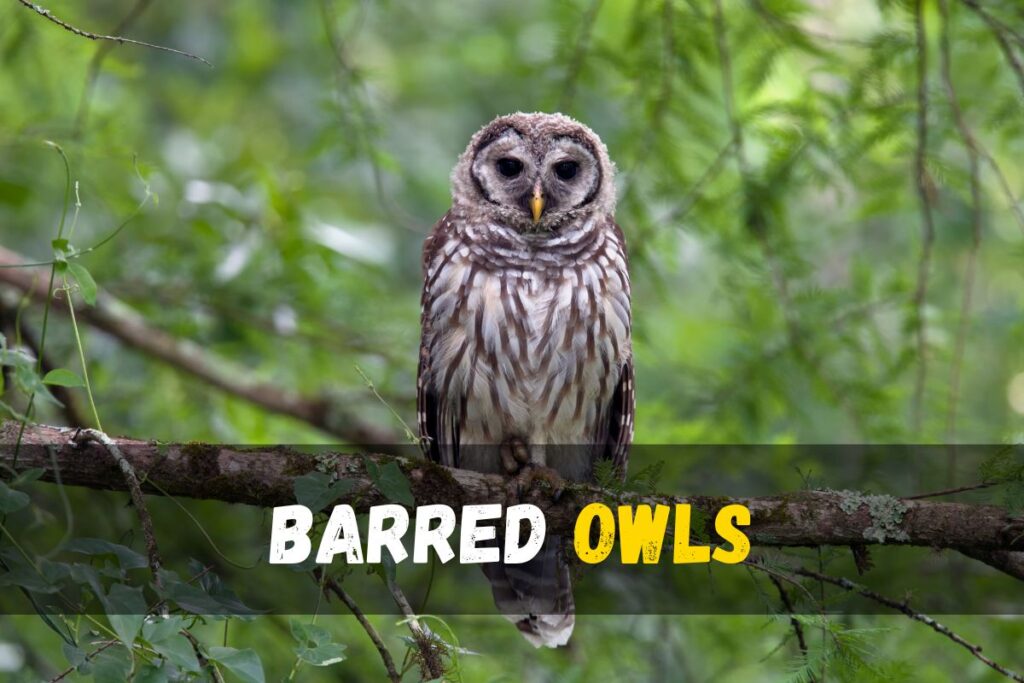
Habitat and Range
Barred Owls are commonly found in mature forests, including both deciduous and evergreen woodlands, across Georgia and much of North America. They prefer dense, dark forests near rivers or wetlands where their primary prey, such as mice, voles, and other small mammals, abound. However, they are also adaptable and can inhabit urban and suburban areas with large trees. Despite their non-migratory nature, they have expanded their range westward, even into areas where they are considered invasive, such as parts of western North America.
Behavior
Known for their distinctive call resembling “who-cooks-for you, who-cooks-for-you-all,” Barred Owls are primarily nocturnal hunters. They have keen hearing, allowing them to locate prey in the darkness of the night. These owls are opportunistic feeders and will consume a wide variety of prey, including mammals, birds, reptiles, amphibians, and insects. They are also known to scavenge for carrion if it’s readily available.
Barred Owls are monogamous and form long-term pair bonds. Courtship displays involve elaborate behaviors such as calling and offering food. Once bonded, the pair will work together to build nests, typically in tree cavities or abandoned nests of other birds. The eggs are mainly incubated by the female while the male is responsible for providing food.
Unique Characteristics and Identification
One of the most distinctive features of Barred Owls is their barred brown and white plumage, which provides excellent camouflage against tree bark. Unlike some owl species, they have bald heads and lack ear tufts. Their calls, including the iconic “who-cooks-for you” hoot, are easily recognizable and are often used for identification purposes.
Where to Find Them
To spot Barred Owls in Georgia, explore areas with dense, mature forests near rivers, wetlands, or urban parks with large trees. They are often found roosting inside tree cavities during the day. Setting up nesting boxes in mature forests before breeding season, which typically occurs between March and August, can attract breeding pairs.
Diet
Barred Owls have a varied diet, feeding on small mammals like mice, voles, and shrews, as well as birds such as ducks and geese. They also prey on reptiles, amphibians, and insects, including snakes, frogs, and beetles. Their opportunistic hunting behavior allows them to adapt to the availability of prey in their habitat.
Great Horned Owl
Description
The Great Horned Owl, scientifically known as Bubo virginianus, is a majestic bird of prey characterized by its mottled brown plumage, large size, and striking yellow eyes. These owls are among the largest in North America, with an average length ranging from 43 to 64 cm and a weight of 1200 to 1600 g. Their distinctive feature includes prominent ear tufts, giving them a “horned” appearance, and a rounded face with reddish coloration in a heart shape. Their plumage helps them blend seamlessly with their surroundings, making them excellent hunters.
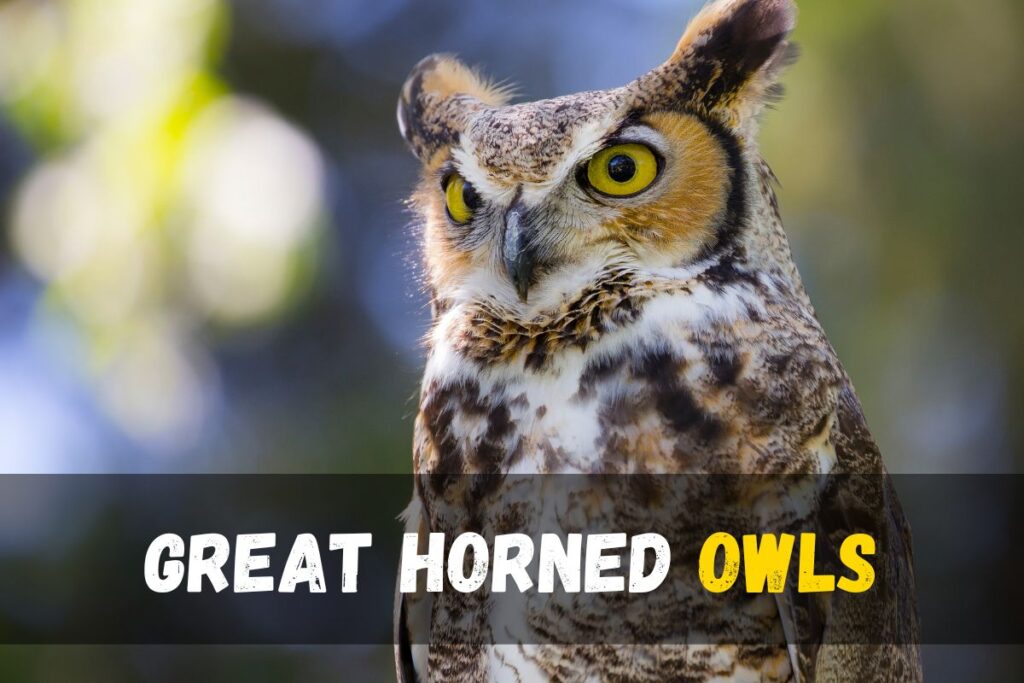
Habitat and Range
Great Horned Owls are incredibly adaptable and can be found in a diverse range of habitats across Georgia and North America. From deciduous and evergreen forests to swamps, marshes, deserts, and even urban areas, these owls can thrive in various environments. They occupy a large range throughout the year, making them a common sight in Georgia’s landscapes.
Behavior
The Great Horned Owl exhibits versatile behavior, adapting to different hunting strategies and nesting habits.
They predominantly hunt at night, relying on their acute senses and noiseless flight to catch prey such as voles, mice, rabbits, and occasionally larger mammals such as skunks and raccoons. During the mating season, which begins as early as January, male owls display impressive aerial maneuvers to attract females and secure nesting sites.
Unique Characteristics and Identification
Identifying the Great Horned Owl is relatively straightforward due to its distinctive features. Apart from their large size and mottled brown plumage, they are recognizable by their deep hooting calls, vibrant yellow eyes, and feathered ear tufts that resemble horns. Their silent flight, thanks to fluffy feathers, further sets them apart from other birds of prey.
Where to Find Them
In Georgia, Great Horned Owls can be spotted in various habitats, including mature pine and hardwood forests, wetlands, suburban areas, and even agricultural lands. Look for them perched on buildings or surveying areas before hunting, as they are often bold and visible during the day.
Diet
Great Horned Owls are apex predators known for their diverse diet. While small mammals like voles, mice, and rabbits constitute their primary food source, they are opportunistic hunters and will prey on birds, reptiles, amphibians, insects, and even other invertebrates when necessary. Their ability to adapt their diet based on seasonal availability ensures their survival in changing environments.
Barn Owl
Description
The American Barn Owl (scientific name: Tyto furcata) is an enchanting bird renowned for its ghostly appearance. With a wingspan ranging from 29 to 36 cm and weighing between 400 to 600 g, it’s a medium-sized owl with a striking white face, chest, and belly. Its upper body and wings are adorned in pale brown hues, presenting a captivating contrast.
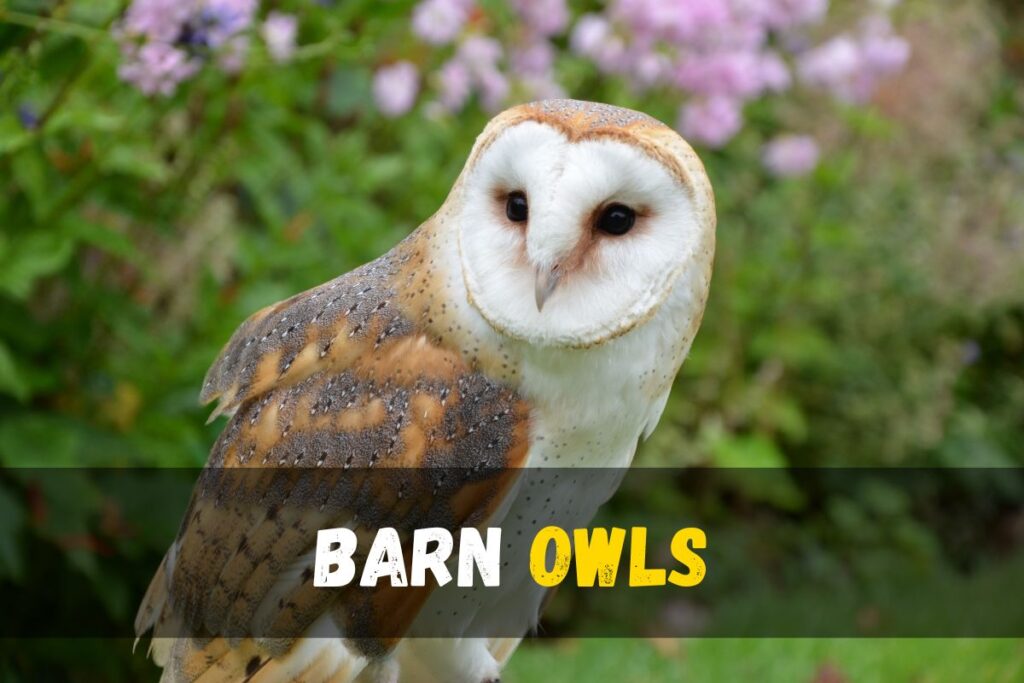
Habitat and Range
Barn Owls thrive in a diverse range of habitats, from open fields and grasslands to wooded areas with ample hunting opportunities. In Georgia, these magnificent birds are commonly found in environments that offer a blend of open fields and woods. They particularly favor areas with old buildings, natural tree cavities, and specially-made nest boxes.
Behavior
Primarily nocturnal hunters, American Barn Owls spend their days concealed in dark, quiet places such as abandoned barns or man-made structures. During the night, they emerge to hunt small rodents using their keen sense of sound, even under snow or vegetation. They form lifetime monogamous pair bonds during nesting season, engaging in courtship rituals before breeding.
Unique Characteristics and Identification
The American Barn Owl’s distinctive features include its heart-shaped, pale white face with piercing black eyes. Unlike some owl species, it lacks ear tufts, giving its head a smooth appearance. Its short tail, rounded wings, and beautiful brown and grey backs make it easily recognizable, especially during flight.
Where to Find Them
In Georgia, prime spots for spotting American Barn Owls include actively farmed areas, where they hunt in fields of corn and soybeans. Famous destinations encompass the Atlanta Botanical Garden, Okefenokee National Wildlife Refuge, Piedmont National Wildlife Refuge, and Crooked River State Park.
Diet
American Barn Owls primarily feed on small mammals such as voles, shrews, mice, and even insects and tiny birds. Their hunting prowess allows them to glide silently through the night air, seizing prey with their sharp talons and hooked beaks. Agricultural landscapes provide ample food sources, including small rodents attracted to farm fields.
Short-Eared Owl
Description
The Short-Eared Owl (Scientific name: Asio flammeus) is a medium-sized owl species known for its distinctive appearance and behavior. It measures between 34 to 43 cm in length and weighs around 200 to 475 g, with a wingspan ranging from 85 to 110 cm. This owl is recognized by its small black bill and spotted brown body, featuring bold brown bars on its wings and tail. Notably, it has a unique habit of hunting during daylight hours, setting it apart from other owl species.
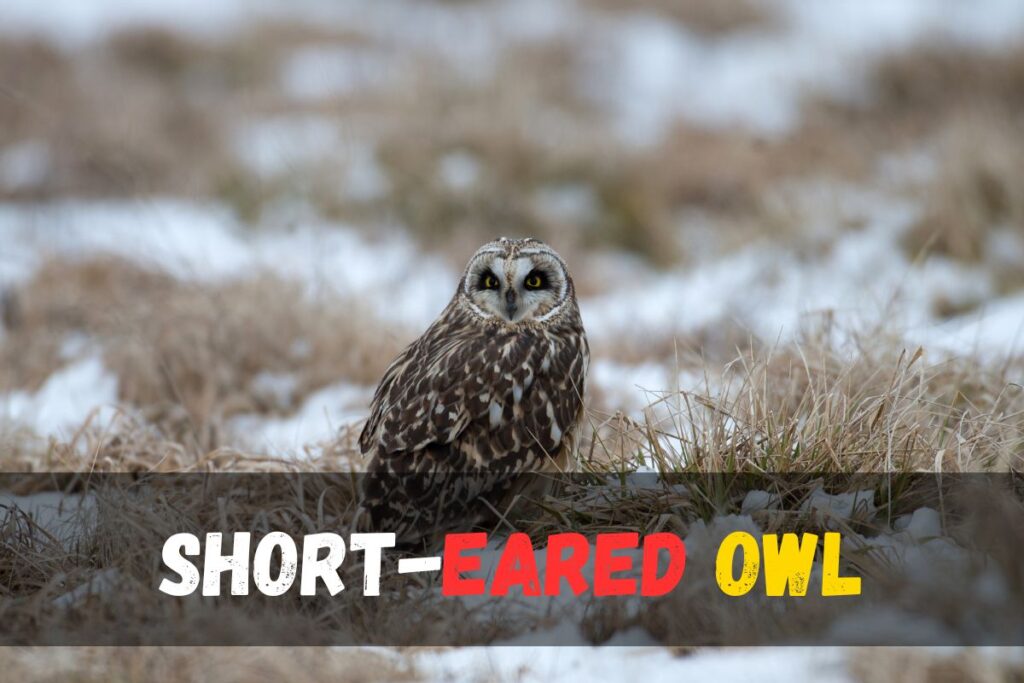
Habitat and Range
Short-Eared Owls have a remarkable global presence, being found in various habitats worldwide. In Georgia, they inhabit open landscapes such as grasslands, meadows, and tundras. They prefer areas with low vegetation and ample open space for hunting. Notable locations to spot them in Georgia include Okefenokee National Wildlife Refuge, Savannah National Wildlife Refuge, and Piedmont National Wildlife Refuge.
Behavior
Unlike many other owl species, Short-Eared Owls exhibit unique nesting and mating habits. They mate serially for a single breeding season starting in March and often live together in flocks. Their nests are constructed on the ground in low-vegetated areas like prairies, meadows, and tundras. These owls are known for their graceful, buoyant flight characterized by smooth, stiff beats, making their movement appear effortless.
Unique Characteristics and Identification
Short-eared owls are easily identified by their distinctive features. They have ear-like tufts of feathers on their heads, contributing to their name. Their plumage consists of white, buff, and brown spots across their backs, short tails, and rounded wings. Notably, their wings usually feature a single white patch, aiding in identification. Facially, they have yellow eyes outlined in black, with a white center interrupted by tan and brown spots. They also possess tiny ear tufts and small black bills.
Where to Find Them
In Georgia, Short-Eared Owls are typically found in open habitats such as grasslands, meadows, and tundras. The best time to spot them is from November to April, especially during dawn and dusk. Unlike most owls, they can frequently be seen during daylight hours as well. Look out for their pale faces with yellow eyes outlined in black, and observe their graceful, silent flight over open lands and fields.
Diet
Short-eared owls are carnivorous birds primarily feeding on small mammals such as voles, rats, mice, and rabbits. They may also occasionally prey on birds, insects, reptiles, and amphibians. Hunting primarily at dawn and dusk, they use their keen senses of hearing and vision to locate prey. Their ability to detect prey by sound, including underground vibrations, makes them efficient hunters. Once prey is captured, they use their sharp talons and beak to kill and consume it.
FAQ’S
Is it Legal to Keep Owls as Pets in Georgia?
In Georgia, it is not legal to keep owls as pets. The laws regarding wildlife vary from state to state, and in Georgia, owls are protected under state and federal regulations. Owls are considered wild animals and are protected to ensure their conservation and well-being in their natural habitats. Keeping owls as pets is prohibited to prevent their exploitation and to maintain ecological balance.
In Georgia, there are specific permits and licenses required for individuals or organizations involved in the rehabilitation or handling of injured or orphaned owls. These permits are issued by the Georgia Department of Natural Resources (DNR) and are aimed at ensuring that only qualified individuals with proper training and facilities care for owls when necessary.
Attempting to keep owls as pets without the proper permits not only violates state and federal laws but also poses risks to both the owls and the people attempting to keep them. Owls have specialized needs that are difficult to meet in a domestic setting, including specific dietary requirements, space for flight, and environmental enrichment. Without proper knowledge and experience, attempting to care for an owl can lead to stress, injury, or even death for the bird.
Instead of keeping owls as pets, individuals interested in these magnificent birds are encouraged to support owl conservation efforts through education, volunteering with wildlife rehabilitation centers, or participating in citizen science projects focused on owl research and conservation. This not only helps protect owls in the wild but also provides opportunities for people to learn more about these fascinating creatures in their natural habitats.
What is the Biggest Owl in Georgia?
The largest owl species found in Georgia is the great horned owl, scientifically known as Bubo virginianus. This owl is commonly referred to as the tiger owl or hoot owl as well. It is recognized for its significant size and is native to the Americas, including Georgia.
What are the most common owls in Georgia?
In Georgia, the Eastern screech owl stands out as the prevailing owl species. These diminutive yet charismatic birds are ubiquitous throughout the state, making them a familiar sight to many residents and visitors alike. Their adaptability to various habitats, ranging from forests to suburban areas, contributes to their widespread presence in Georgia’s ecosystem. As a result, the Eastern screech owl holds the title of the most frequently encountered owl in the region. Their distinctive calls echo through the night, adding to the ambiance of Georgia’s natural surroundings. Whether perched silently on a branch or actively hunting for prey, these owls symbolize the rich biodiversity and allure of Georgia’s avian population.


